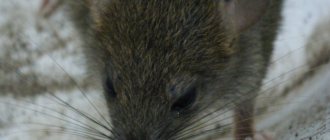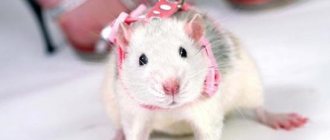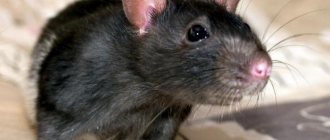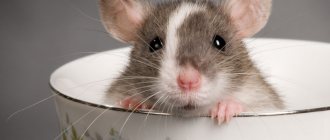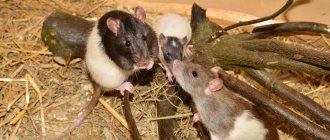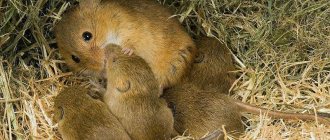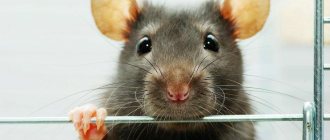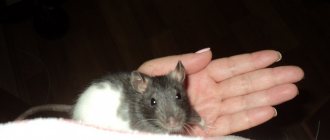Rat nutritional features
Rats are omnivores, but each species has its own preferences. Some people eat more plant foods, seeds, vegetables, and fruits. Others prefer insects, mollusks, and small invertebrates. For example, the diet of a gray rat always contains animal protein, fish and amphibians, mollusks, small rodents and insectivores. From plant foods, rats feed on seeds, grains, and succulent parts of plants. Near a person they find all available food products, waste, livestock and poultry feed. There are practically no stocks.
A rat consumes 20-25 g of food per day, and 7-10 kg of food per year. Rats endure hunger very hard; without food they die on the 3-4th day. They die even faster in the absence of water. A rat usually drinks 30-35 ml of water per day, 5-10 ml if wet food is available.
Feeding
Do you want to know what to feed your kitty rat? Everything is quite simple, especially since pets are unpretentious in food.
Note!
Domestic hedgehog - a review of the best hedgehog breeds to keep, all the features of the pet from feeding to living conditions! + photos and videos
Domestic goat - an overview of the features of keeping goats, how to care for them and what to feed them, as well as diseases, treatment and prevention of diseases in the review!
Sheep - learn everything about keeping sheep, features of living conditions, diet and the main characteristics of sheep as a pet!
The rat menu should consist of:
Grain. Experienced owners prepare and select the ingredients for feeding themselves. A ready-made mixture of grains can be purchased at almost any pet store.
Vegetables, herbs and fruits. In small quantities. There is no need for any special products here; common vegetables and fruits are quite suitable for rats. Herbs such as dill and parsley will also suit their taste.
Protein food. A little meat, cottage cheese or cheese. These products are not for your daily diet.
List of foods that should not be given to rodents: sweets, legumes, cabbage, sausage, soda and chips. Make sure your pet does not eat indoor plants, as this may be life-threatening.
Common types of rat
Gray rat, or pasyuk (Rattus norvegicus)
Body length without tail is 17-25 cm, weight 140-390 g. The tail is shorter than the body, up to 19.5 cm in length. The muzzle is blunt and wide, the ears are small. The color is gray with red in adults. The hair on the abdomen is white with dark bases. Sometimes there are black individuals.
The species is distributed on all continents except Antarctica. Eastern Asia is considered the homeland of the gray rat, from where they passively settled mainly on sea vessels.
Tan Rat (Rattus adustus)
Endemic to the island of Engano, which is located 100 km southwest of Sumatra (Indonesia). Outwardly it resembles a gray rat, but is more red in color.
Kinabuli rat (Rattus baluensis)
The species is found in Malaysia in northern Borneo at altitudes of 1524-3810 m above sea level. Lives in mountain and moss forests. Outwardly similar to a gray rat.
Black rat (Rattus rattus)
Smaller in size than the gray rat. Body length is 15-22 cm, weight 132-300 g. The tail is covered with dense hairs, longer than the body. The muzzle is narrow, the ears are large and round in shape. There are two color options:
- dark or black-brown above with a greenish tint of guard hairs; light sides; ashy or dirty gray tummy;
- on top the color is like that of a gray rat, but lighter and yellower, the tummy is whitish or yellowish.
Southern forms are usually larger and lighter in color than northern ones.
The species is cosmopolitan, distributed in Europe, Asia, Africa, America, and Australia.
Australian swamp rat (Rattus lutreolus)
Body length 12-20 cm, tail length 56-150 mm, weight about 115 g. The coat is gray-brown or dark gray on top, the belly is usually lighter, from brown to cream color. The hairs have golden tips. The ears are small and invisible in the fur. The tail is scaly with sparse hairs.
The species is found southeast of Fraser Island and south to Kangaroo Island, Tasmania, Bass Strait Islands, Queensland, up to 1600 m above sea level.
Long-haired rat (Rattus villosissimus)
Endemic to central and northern Australia, where it lives in arid or desert areas. Outwardly similar to a black rat.
Small rat (Rattus exulans)
The body is short, the muzzle is pointed, the ears are large, the color is brown. Body length is from 11.5 to 15 cm (without tail), the tail is thin, with “rings” on the surface. The length of the tail is equal to the length of the body. Weight is 40-80 g.
This is the third most common species of rat in the world. Indonesia is recognized as its homeland, from where the small rat was distributed throughout Southeast Asia and Oceania. Lives in steppes, fields and forests. Kept as a pet.
Other breeds
Through the process of crossing different species, many different breeds were developed. Some of them are not officially recognized because they are considered abnormal.
- Rex. The fur of this species of rat is curly and stiff. It seems to be sticking out in different directions. These animals have short, curling whiskers.
- Double rex. This variety has a striking distinctive feature, as it is susceptible to molting. Because of this, areas of curly hair alternate with bald spots. When hair grows on bald areas, it begins to fall out on those that had vegetation. These rats are not officially recognized.
- The breed of long-haired rats is otherwise called satin. Such animals do not differ in size from standard rats, but their fur is slightly elongated and very shiny.
- Husky. This species resembles a dog breed of the same name. On the animal’s muzzle there is a white mask of the same shape as that of dogs of this breed. They have the amazing feature of changing the color of their coat throughout their lives (colored wool is eventually replaced by white hairs).
Husky breed - Curly rats resemble lambs in appearance. They have a velvety, shiny and curly coat. On their bellies it can be either regular or curly.
- Wavy. These animals have thick, soft, fluffy and wavy fur.
- Odd-eyed. This is the most unusual type of rodent. The eyes of its representatives have different colors.
Rats are smart, beautiful, flexible and plastic animals. They are loved and bred by many. These rodents have helped humanity many times. For example, with their help, many drugs have been developed that save human lives. However, children and many adults love them simply for what they are, because they are quite cute and friendly. Now you have become acquainted with all types and breeds of decorative rats. It's time to go buy a pet!
Great article 21
Rat behavior
Rats lead a terrestrial or semi-arboreal lifestyle. In order to hide, they use burrows, which they dig themselves or by finding abandoned empty burrows of other animals. They live either alone or in family or territorial groups. There are up to several hundred or thousands of individuals in colonies. There is a hierarchy within the group. The colony occupies an area of up to 2000 m2, and marks it with scent marks.
Rats are active at night and at dusk. They often settle next to a person and easily adapt to his activity.
Content Rules
Keeping decorative rats does not require any special wisdom. The main thing to do is to purchase a spacious cage.
Animals love to move, so they need space. The cage must be equipped:
- filler - the ideal option would be dry wood (it absorbs odors and liquids well);
- a house - a rat sometimes needs privacy;
- tunnels and ladders - pets will definitely want to play and run around;
- drinking bowl with fresh and clean water;
- a feeder well fixed to the rods;
- mineral stone so that animals can chew it.
It is strictly forbidden to use litter made from coniferous trees for decorative rats. It can cause serious illness and even death.
You can complement the design of the cage with various toys and treats for rodents.
Rat breeding
They breed throughout the year, except in northern populations. The gray rat has 2-22 cubs in one litter, on average 8-9, in Malayan species from 3 to 6, in Australian species from 3 to 14
Under natural conditions, rats breed in warm weather, 2-3 times a year, and in heated rooms - all year round, breeding up to 8 offspring. The breeding cycle has a spring and autumn peak.
Pregnancy lasts 22-24 days. Babies weigh 4-6 g and are born naked, blind, with closed ear canals. Stillborn and weak rat pups are eaten by females. Males do not take part in raising offspring. The eyes of rat pups open 2 weeks after birth. At the age of 3-4 weeks they become independent. Females reach sexual maturity at 3-4 months.
The lifespan of rats in nature is from 1.5 to 3 years.
Dossier
Rat.
CC0
Full name: Norway rat (gray), black rat, Bosavi and others.
Nicknames. Pasyuk, kurako, shchur.
Signs. Unevenly gray (“agouti”), sometimes with reddish spots, black, white, mottled.
Special signs. Hairless tail, poor eyesight.
Place of residence: planet Earth.
Character: persistent.
Intelligence: above average.
Suspected: in the death of dinosaurs.
Accused of : causing death by negligence of 25 million people in the 14th century alone; theft of someone else's property by an organized group on an especially large scale; destruction or damage to someone else's property, resulting in particularly grave consequences.
Interesting facts about the rodent:
- Rats cause economic damage as they eat and spoil food and non-food products, damage electrical networks, and cause damage to agriculture. In addition, they are a natural reservoir for many zoonotic and anthropozoonotic infections (plague, tularemia, rabies, typhus, toxoplasmosis, leptospirosis, rickettsiosis). Therefore, many methods have been developed for their destruction - deratization. But rats can adapt to and recognize poisons.
- In the United States, rats bite about 14,000 people every year.
- Since the 19th century, specially bred rats have been kept as pets. They are also bred as “live food” for home terrariums and zoos.
- Rats are the main experimental system in biological and medical experiments. Special laboratory rats were bred for this purpose. They are distinguished by their fast metabolism, unpretentiousness and peaceful nature.
- Rats are considered very intelligent animals; along with humans, they have abstract thinking. In addition, they respond to tickling and produce ultrasonic laughter-like sounds.
- In China, the rat is a symbol of prosperity and the first animal to open the cycle of the eastern horoscope. In Islam, the rat is the embodiment of sensuality, and Hinduism represents the rat as a former demon.
Gnaws everything in sight
And the trouble is not only in our heroine’s good appetite. The rat needs to grind its teeth all the time - after all, its incisors are constantly growing at a speed of up to 2-3 mm per week. And God forbid if they get their teeth into something super important!
Once in Japan, a rat stopped 16 trains on the Tokyo-Osaka line. The investigation into the case showed that the scoundrel chewed through the alarm cable and turned off the traffic lights.
In the house of an altapress.ru friend, a rat named Krysya chewed the phone buttons, the Mac keyboard and got to the computer mouse. The battle between the rat and the mouse ended with the acquisition of new and expensive peripheral devices, and the hooligan was briefly placed in an isolation ward - a cage.
Isolating it is the only way out, because it is hardly possible to hide anything from this creature. She easily jumps to a height of up to a meter, makes her way between vertical surfaces to the target, and moves through pipes. And at the same time, he easily remembers the most winding path, feeling comfortable in city communications.
Rat.
visualhunt.com
Dreams and dies from stress
Researchers say rats dream. They giggle when tickled. They grind their teeth with pleasure when they are stroked - just like cats purr. They are able to express pleasure and happiness on their faces. Believe it or not.
They even tell miracles about trained rats: they can supposedly drink tea decorously at a common table, serve slippers, stand on guard with a “gun” - a sliver of wood behind their backs. And drop dead if a child points a toy gun in their direction. Who else would reveal the secret of their training...
Rats are one of the few animals on the planet that can die from psychological pressure. And their fellow species kills them - for example, when a stranger comes to the colony.
This is how it is described: the head of the colony circles around his victim, raising his fur and snapping his teeth. The guest lies without getting up and breathing intermittently. The aggressor walks around the victim - and she dies from stress after a few difficult hours.
Rat.
visualhunt.com
Danger to humans
The confrontation between humans and rats has lasted for thousands of years. In our time, such a struggle has received an official name - rodent control. Despite its notoriety in Europe and many other countries, including the Americas, in some countries of the East this rodent received the status of a divine animal that symbolizes wealth, wisdom, prosperity, etc. The negative image of this rodent is associated with several plague epidemics in Europe, which were carried by rats.
Important point! Rats are involved in serious economic losses that are associated with spoilage and consumption of various types of goods, both food and other purposes. These rodents damage the insulation of electrical networks, which leads to fires that claim the lives of many people, not to mention damage to property.
Some species of rats cause serious damage to agricultural crops because they simply destroy crops. Therefore, in such conditions, people resort to various methods of protecting crops from rodent invasion. In some cases they are simply scared away, and in others they are physically destroyed. Currently, rats pose a serious threat to the health of all humanity, since these rodents carry pathogens of dangerous diseases. The danger of their vital activity also lies in the fact that these rodents are able to completely unnoticedly penetrate into a human home through sewage and ventilation systems.
Despite the constant and serious fight against rats and other rodents, it has not yet been possible to completely destroy them, but it is still possible to control the populations of these pests.
Experts have established certain norms for deratization, which is associated with the optimal percentage of freeing the territory from rodents.
Therefore it is considered:
- 80% – the result is satisfactory.
- 90% is a good result.
- 95% is an excellent result.
In this regard, it is generally accepted that the task of special deratization services is to maintain in a certain area an acceptable percentage of rodents that would not be able to cause much damage to human life.
Characterized by intelligence
Yet the secret to the success of this species lies largely in its intelligence. It’s not for nothing that the Polish zoologist Miroslav Gushch called him an intellectual of the animal world.
Here's the plot: a rat trap with poisoned bait. Do you think this is the end of the rodent? No matter how it is. Rats are suspicious of new foods. And if their poor comrades fall for the poison, the rest will quickly realize what’s going on and won’t touch the bait.
Some scientists are even sure: rats deliberately send their friends, who are on the lower steps of the hierarchy, to taste the bait. And if they went to their forefathers, the old experienced animals will stain the poisonous food with droppings.
Moreover, observers note that they are even able to shake the dangerous bait out of the rat trap and bury it in the ground - so that careless youth are not in danger.
Rat.
visualhunt.com
Wool standardization
In contrast to the numerous markings, there are not many types of wool at all, and they have long been standardized. “Standard” by its name makes it clear that this type of wool is the most common. It is smooth and looks like gloss. Those animals whose fur is stiffer, denser and coarser are classified as “curly” hair type; all their hair and even their mustache curls.
There is also a “wavy” type, which differs from “curly” only in having softer hair. “Satin” is a type of wool that is more shiny and fine.
In the 2000s, long-haired rats also appeared; they have slightly larger fur than standard ones. There are few other species; rather, they are determined by the absence of hair. Therefore, hairless rats are only decorative and were bred quite recently.
Source
How often should deratization be carried out?
Deratization should be carried out as needed, that is, at the first, even indirect, signs of the appearance of rats in the room. Evidence of rodents visiting the site can be their excrement, teeth marks on various surfaces, scattered food, bits of food and other evidence left by the “raiders” at the crime scene. However, according to the law of the Russian Federation, there are a number of social facilities where it is necessary to carry out rat control once a month for preventive purposes in order to eliminate the possibility of rats appearing. Proactive action should be taken in all facilities where food is stored, processed, packaged or prepared. Such objects include:
- Public catering points;
- Enterprises producing or processing products;
- Kindergartens;
- Schools;
- Sanatoriums and holiday homes;
- Hospitals;
- Nursing home;
- Terminals and storage;
- And other similar objects;
Use as pets
Thanks to their natural intelligence, rats are easy to train. Most often, gray rodents become pets.
Caring for rats is not difficult. The animals are friendly and clean, but when feeding your pets you should follow moderation and listen to the advice of specialists and a veterinarian.
Important! Such rodents should not be kept alone. These animals are accustomed to living collectively; they feel good only in the company of their relatives.
Body structure
Experts say that street rats have the ability to adapt and survive in almost any environment. But despite all this, they have very poor eyesight. This is explained by the structure of the lens. The structure of the lens makes it possible to see everything that surrounds it at an angle of 16º. To see much more, the rat is forced to constantly turn its head. They see almost everything that surrounds them in gray. They also have the ability to see the bluish-green part of the light spectrum. In red they see complete darkness.
Rats have very well developed senses of smell. Despite this, animals are not able to use this feature over long distances. This characteristic of the organism can be explained by the fact that evolution and natural selection determined it this way. The life of these animals occurs in such conditions that they simply do not need to have a higher sense. Despite this, at short distances, rats are very good at distinguishing all odors. They constantly examine each other using their sense of smell to understand who is nearby - their own or someone else's.
There are different types of rats
A certain feature is observed in the structure of the hearing organs. Rats can hear sounds even at frequencies around 40,000 Hz. Animals react very quickly even to the quietest noises. A very interesting fact is that pure sounds are not perceived by their ears at all.
Communication occurs with the help of a characteristic squeak. Rats have the best developed sense of touch. This has been confirmed through special studies. Special vibrissae act as organs of touch - these are small sensitive hairs. There are a lot of these hairs on the face.
Rodents have a very clear understanding of the tastes of food. In this respect they are not at all different from other existing species of mammals. The ability to distinguish taste is explained by the presence of small filiform papillae on the surface of the tongue. At the top they are covered with a special keratinized epithelium. This makes it possible to better retain food in the mouth. Rats have very well developed salivary glands, and the parotid, submandibular and sublingual glands are considered the most developed. The functioning of these glands ensures the production of saliva in the oral cavity, which is necessary for digesting food and wetting dust particles. Rodents need to wet the dust with saliva when they are setting up their home, or rather digging a hole.
These rodents have very strong teeth
